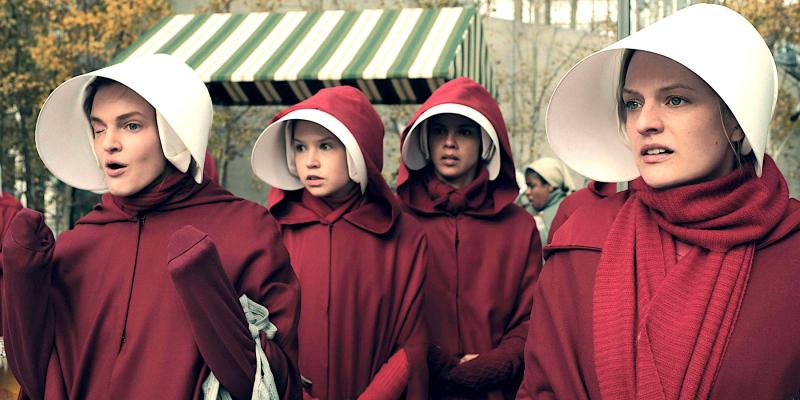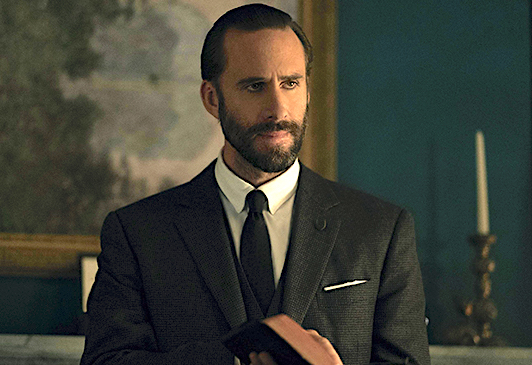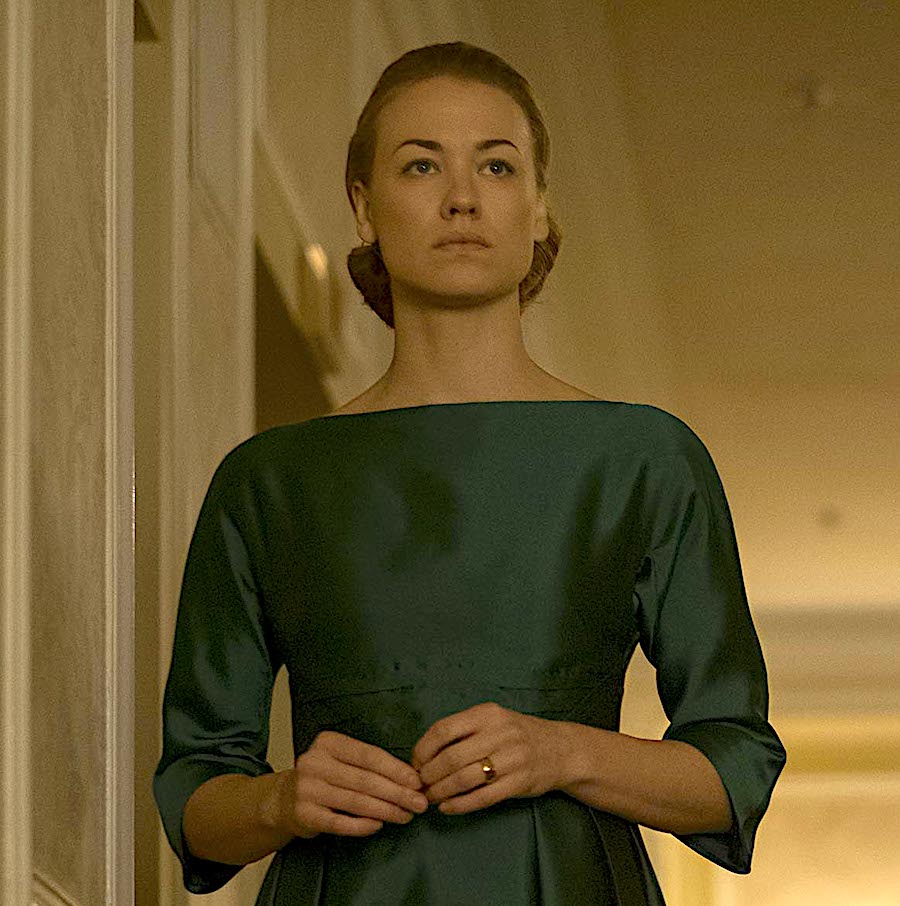The Handmaid's Tale, Series 1 finale, Channel 4 review - exquisite to look at but glacially slow | reviews, news & interviews
The Handmaid's Tale, Series 1 finale, Channel 4 review - exquisite to look at but glacially slow
The Handmaid's Tale, Series 1 finale, Channel 4 review - exquisite to look at but glacially slow
Not so much an ending, more a set-up for series 2

Come awards time, it’s inevitable that Elisabeth Moss will be collecting a few for her portrayal of Offred, the endlessly-suffering lead character in The Handmaid’s Tale (her real name is June). But I reckon the real stars of the show are cinematographer Colin Watkinson plus the production design and art direction teams.
There were those post-Puritan white and maroon outfits worn by Offred and her fellow-handmaids, often choreographed en masse in muted, wintry New England landscapes, and interiors draped in soft, gauzy light and melancholic near-sepia colourings. There was a scene in this series closer when Serena Joy (Yvonne Strahovski), the bitterly dissatisfied wife of Commander Fred (Joseph Fiennes, pictured below), was framed in a bedroom that looked like a lost Arts and Crafts masterpiece, with its hanging illustrations of birds and flowers, and drapes, wallpapers and Serena Joy’s dress in subtly matched teal-like shades.
 The series has been so spellbinding to look at that it became quite easy to overlook the fact that dramatic development frequently ground to a halt. Once the nature of the brutish Republic of Gilead had been established, and we’d got the hang of a fascistic theocracy run by bullying, hypocritical men in which women weren’t allowed to read books, handle money or get jobs and were only there to procreate – by force, in the case of the handmaids – a lot of the running time was taken up merely by observing the drab and fearful routines of the people stuck in this Old Testament nightmare. Another notable victim is Serena Joy (pictured below), one of the intellectual architects of the Gilead project who was horrified to find that she’d written herself out of her own life. Duh.
The series has been so spellbinding to look at that it became quite easy to overlook the fact that dramatic development frequently ground to a halt. Once the nature of the brutish Republic of Gilead had been established, and we’d got the hang of a fascistic theocracy run by bullying, hypocritical men in which women weren’t allowed to read books, handle money or get jobs and were only there to procreate – by force, in the case of the handmaids – a lot of the running time was taken up merely by observing the drab and fearful routines of the people stuck in this Old Testament nightmare. Another notable victim is Serena Joy (pictured below), one of the intellectual architects of the Gilead project who was horrified to find that she’d written herself out of her own life. Duh.
Some critics have decided that Gilead is a representation of Trump’s America, though his bickering gang who couldn’t shoot straight would have difficulty organising a Little League baseball game, let alone overthrowing the American Constitution. Surely what Handmaid most resembles is rule by ISIS or the Taliban, whose hideous punishments and mutilations, public executions and institutionalised rape would be all too recognisable to Offred. An opportunity to ponder religious extremism in all its forms, perhaps.
 Atwood’s source novel has been mined thoroughly for series one, so the planned series 2 (and beyond) will depend on the creativity of the screenwriters. This risks shifting it away from the author’s original design of an imaginative exploration of what an ultra-religious or totalitarian takeover of a US-style democracy might look like – though it’s hard to see how this bunch of sick weirdos could have managed it – and turn it into just another adventure series.
Atwood’s source novel has been mined thoroughly for series one, so the planned series 2 (and beyond) will depend on the creativity of the screenwriters. This risks shifting it away from the author’s original design of an imaginative exploration of what an ultra-religious or totalitarian takeover of a US-style democracy might look like – though it’s hard to see how this bunch of sick weirdos could have managed it – and turn it into just another adventure series.
Thus, one began to suspect that the production team were eking out their source material as parsimoniously as possible as the episodes slid glacially by. Action sequences have been minimal, though effective – the scene of protesters being ruthlessly crushed by heavily-armed militia spoke volumes about the Gilead mentality, while most of one episode was given over to the story of how Offred’s husband managed to escape to still-democratic Canada with help from the underground resistance movement.
This finale brought us a pivotal moment when the handmaids refused orders to stone to death one of their own, after which Offred was carted off by thuggish goons in a black SUV. She might be about to be rescued, or she may have been condemned to death. The incongruous strains of Tom Petty’s “American Girl” ringing out over the end shot – “she couldn’t help thinkin’ that there was a little more to life somewhere else”– must surely betoken an optimistic outcome. But having reached this climactic moment, it was exasperating not to to get an ending, but be told to go away and wait for the second season.
Add comment
The future of Arts Journalism
You can stop theartsdesk.com closing!
We urgently need financing to survive. Our fundraising drive has thus far raised £49,000 but we need to reach £100,000 or we will be forced to close. Please contribute here: https://gofund.me/c3f6033d
And if you can forward this information to anyone who might assist, we’d be grateful.

Subscribe to theartsdesk.com
Thank you for continuing to read our work on theartsdesk.com. For unlimited access to every article in its entirety, including our archive of more than 15,000 pieces, we're asking for £5 per month or £40 per year. We feel it's a very good deal, and hope you do too.
To take a subscription now simply click here.
And if you're looking for that extra gift for a friend or family member, why not treat them to a theartsdesk.com gift subscription?
more TV
 Murder Before Evensong, Acorn TV review - death comes to the picturesque village of Champton
The Rev Richard Coles's sleuthing cleric hits the screen
Murder Before Evensong, Acorn TV review - death comes to the picturesque village of Champton
The Rev Richard Coles's sleuthing cleric hits the screen
 Black Rabbit, Netflix review - grime and punishment in New York City
Jude Law and Jason Bateman tread the thin line between love and hate
Black Rabbit, Netflix review - grime and punishment in New York City
Jude Law and Jason Bateman tread the thin line between love and hate
 The Hack, ITV review - plodding anatomy of twin UK scandals
Jack Thorne's skill can't disguise the bagginess of his double-headed material
The Hack, ITV review - plodding anatomy of twin UK scandals
Jack Thorne's skill can't disguise the bagginess of his double-headed material
 Slow Horses, Series 5, Apple TV+ review - terror, trauma and impeccable comic timing
Jackson Lamb's band of MI5 misfits continues to fascinate and amuse
Slow Horses, Series 5, Apple TV+ review - terror, trauma and impeccable comic timing
Jackson Lamb's band of MI5 misfits continues to fascinate and amuse
 Coldwater, ITV1 review - horror and black comedy in the Highlands
Superb cast lights up David Ireland's cunning thriller
Coldwater, ITV1 review - horror and black comedy in the Highlands
Superb cast lights up David Ireland's cunning thriller
 Blu-ray: The Sweeney - Series One
Influential and entertaining 1970s police drama, handsomely restored
Blu-ray: The Sweeney - Series One
Influential and entertaining 1970s police drama, handsomely restored
 I Fought the Law, ITVX review - how an 800-year-old law was challenged and changed
Sheridan Smith's raw performance dominates ITV's new docudrama about injustice
I Fought the Law, ITVX review - how an 800-year-old law was challenged and changed
Sheridan Smith's raw performance dominates ITV's new docudrama about injustice
 The Paper, Sky Max review - a spinoff of the US Office worth waiting 20 years for
Perfectly judged recycling of the original's key elements, with a star turn at its heart
The Paper, Sky Max review - a spinoff of the US Office worth waiting 20 years for
Perfectly judged recycling of the original's key elements, with a star turn at its heart
 The Guest, BBC One review - be careful what you wish for
A terrific Eve Myles stars in addictive Welsh mystery
The Guest, BBC One review - be careful what you wish for
A terrific Eve Myles stars in addictive Welsh mystery
 theartsdesk Q&A: Suranne Jones on 'Hostage', power pants and politics
The star and producer talks about taking on the role of Prime Minister, wearing high heels and living in the public eye
theartsdesk Q&A: Suranne Jones on 'Hostage', power pants and politics
The star and producer talks about taking on the role of Prime Minister, wearing high heels and living in the public eye
 King & Conqueror, BBC One review - not many kicks in 1066
Turgid medieval drama leaves viewers in the dark
King & Conqueror, BBC One review - not many kicks in 1066
Turgid medieval drama leaves viewers in the dark
 Hostage, Netflix review - entente not-too-cordiale
Suranne Jones and Julie Delpy cross swords in confused political drama
Hostage, Netflix review - entente not-too-cordiale
Suranne Jones and Julie Delpy cross swords in confused political drama

Comments
It's how the book ends too.
Yes, except for the epilogue.